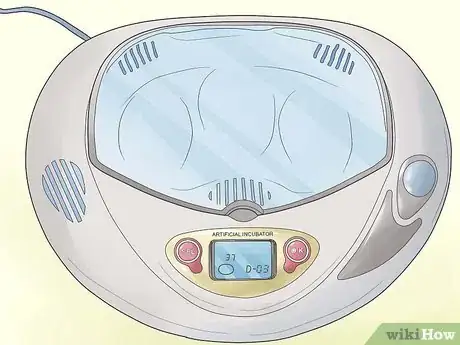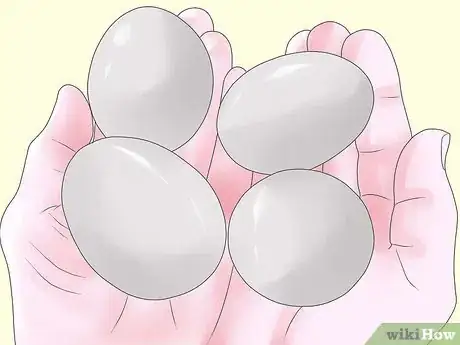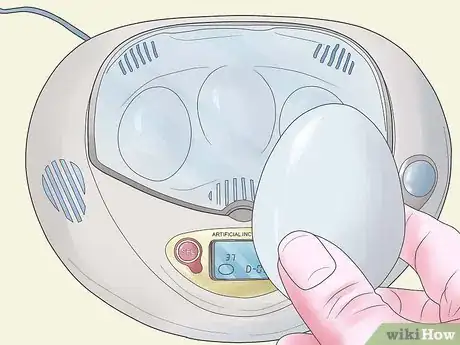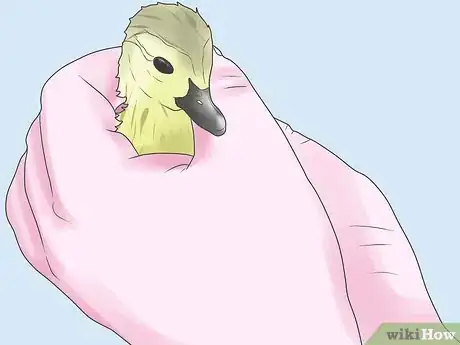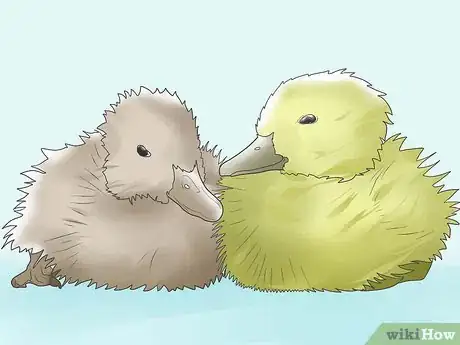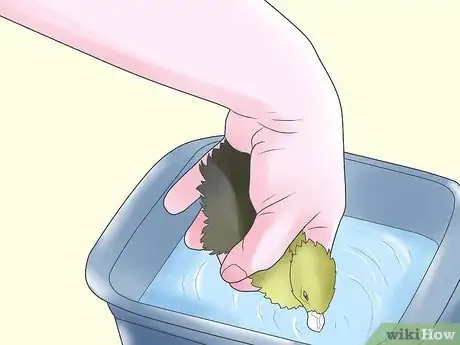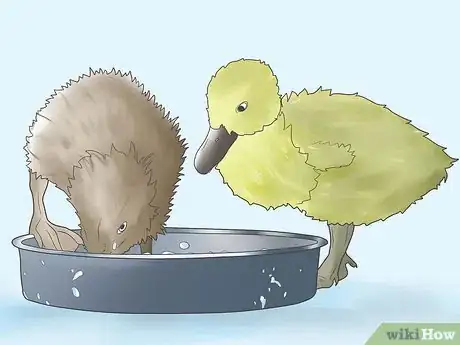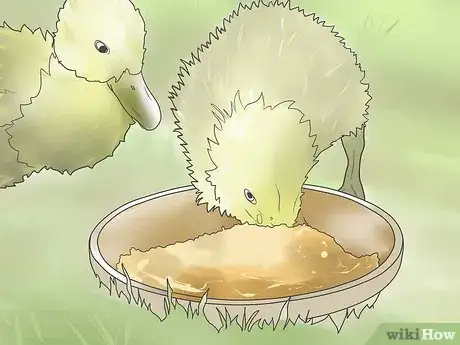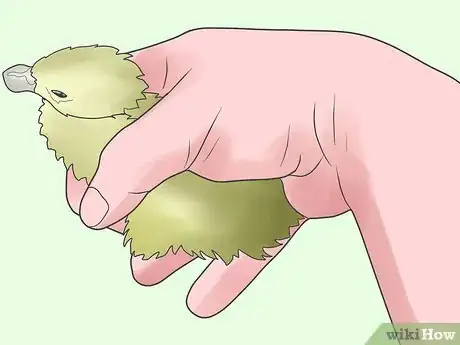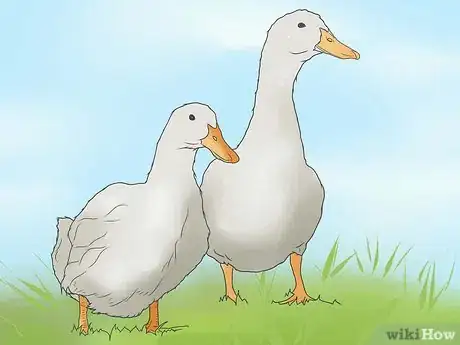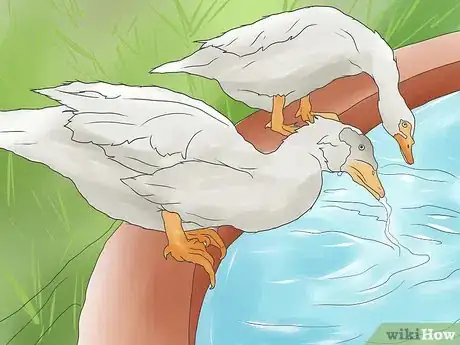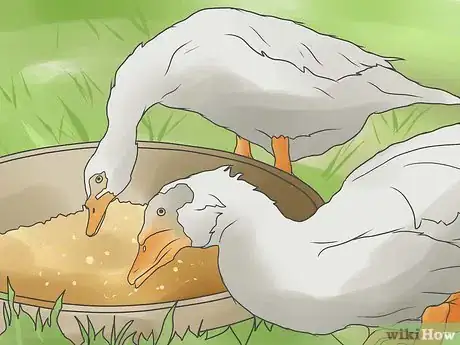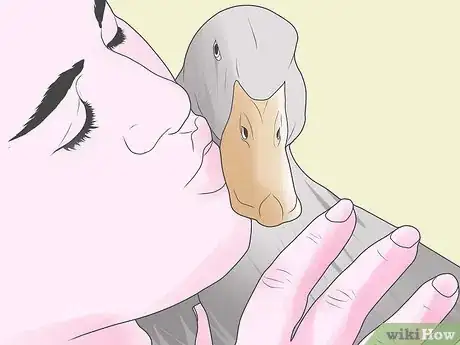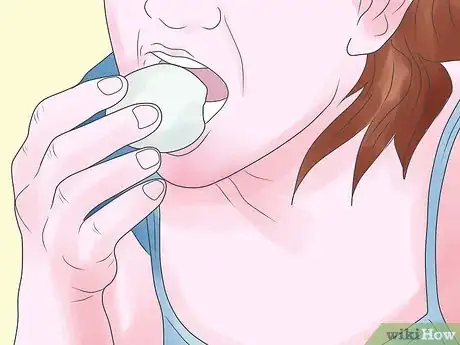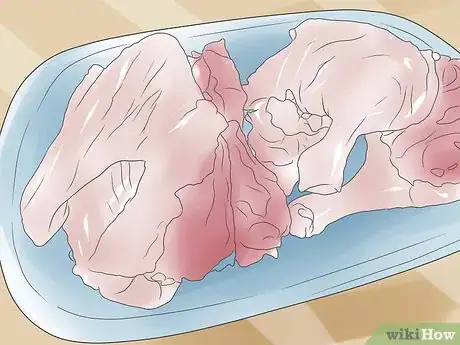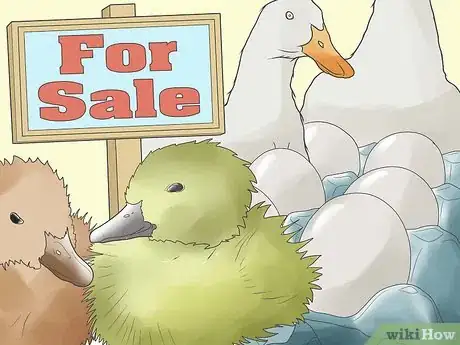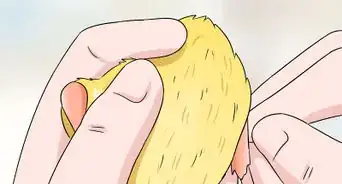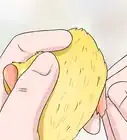wikiHow is a “wiki,” similar to Wikipedia, which means that many of our articles are co-written by multiple authors. To create this article, 16 people, some anonymous, worked to edit and improve it over time.
wikiHow marks an article as reader-approved once it receives enough positive feedback. This article received 17 testimonials and 93% of readers who voted found it helpful, earning it our reader-approved status.
This article has been viewed 160,821 times.
Learn more...
Once you decide to raise ducks, you need to be dedicated to their care and well being, and the task is not necessarily a simple one. They tend to be easier to care for than other types of fowl, however, and many people find them to be enjoyable to watch and tend to. Keep reading for more information if you're thinking about raising ducks from the egg, duckling, or adult stage.
Steps
Hatching Duck Eggs
-
1Plan ahead of time. Duck eggs usually take 28 days to hatch, but some breeds take as long as 35 days. You need to make sure that your incubator is prepared in advance before you purchase duck eggs and attempt to hatch them.
- Duck eggs are larger than chicken eggs, so many chicken egg incubators will not accommodate duck eggs. Make sure that the tray used in the incubator is large enough.
-
2Let the incubator stabilize before placing the eggs inside. Set the temperature to 99.5 degrees Fahrenheit (37.5 degrees Celsius) and the relative humidity at 55 percent, or 84.5 degrees Fahrenheit (29 degrees Celsius) on a wet bulb thermometer.
- The ventilation should be set according to the manufacturer's instructions.
- Let the incubator stabilize for a full day or two before adding the eggs.
Advertisement -
3Carefully select the eggs you use. The eggs must be in good shape in order to hatch.
- Avoid eggs that are cracked, double yolked, misshapen, oversized, undersized, or dirty.
- Ideally, the eggs should be set in an incubator one to three days after they were laid.
-
4Check the incubator four times daily. After you place the eggs in the incubator, you should check them at least four times each day. When you check them, turn them over, so that they receive even heat on all sides.
- On the first day, you should check the eggs roughly every hour.
-
5Remove unfit eggs after the first week. If there are any eggs with clear shells, that means that the eggs are infertile. Eggs with cloudy shells are dead inside. Remove both types of eggs from the incubator and leave the rest alone.
-
6Transfer the eggs to hatching trays after 25 days. You can either remove them to a separate hatching machine or change the settings of the incubator to accommodate the eggs as they hatch.
- The temperature should be at 99 degrees Fahrenheit (37.2 degrees Celsius) with a humidity of 65 percent.
- Increase the humidity to 80 percent and increase the ventilation openings by 50 percent once the eggs begin to pip or change notably.
- Within the last 6 to 12 hours, just before the end of the hatch, decrease the temperature to 97 degrees Fahrenheit (36.1 degrees Celsius) and the humidity to 70 percent. Open the vents all the way.
-
7Remove hatched ducklings from the hatcher. Once 90 to 95 percent of the ducklings have hatched and dried, you should remove them from the hatcher and transfer them to a brooder.
Caring for Ducklings
-
1Buy as few as two ducklings. If you are buying ducklings instead of raising them from eggs, buy about two to four.
- You will be able to care for a smaller number better, especially if raising ducks is a new experience for you, but you should also have more than one duckling to prevent that duckling from feeling lonely. Ducks need to socialize with other ducks.
- Oftentimes, if you buy from a hatchery, you will be sold 10 to 15 ducklings at minimum. This amount can be overwhelming, so consider pawning off some of the ducklings on responsible friends and relatives.
-
2Dip the beaks in shallow room temperature water. If you buy ducklings instead of hatching them. You should dip the tip of each bill into shallow water or sugar water to hydrate them.
- If using sugar water, use 1/3 cup (80 ml) sugar per 1 gallon (4 L) of water.
-
3Always provide the ducklings with plenty of water. Water makes it easier for ducklings to swallow food and clean their beak vents. You should give ducklings access to water for a minimum of one hour before and after feeding.
- Chick fountains and shallow bowls are recommended for ducklings. Be prepared to clean the area often, however, since ducklings enjoy splashing around in the water.
- A week-old duckling will drink about 1/2 gallon (2 L) of water weekly. By the age of seven weeks, ducklings drink 1⁄2 gallon (1.9 L) (2 L) of water daily.
- Make sure that the water is no deeper than 1/4 inch (6.35 mm) to prevent the ducklings from drowning.[1]
- Be aware of the fact that ducklings do not produce waterproofing oil until they reach four weeks old. Mother ducks apply it to the ducklings before this in the wild, but domestic ducklings cannot be allowed to swim before this age since they will not have developed any oils of their own.
- Until ducklings reach the age of one month, they should only be allowed to enjoy short swims under close supervision. You can do this by filling a small plastic tub with warm water and letting them splash around for 2 to 5 minutes. Dry them off before returning them to the brooder.
-
4Set up a brooder for your ducklings. Keep your ducklings safe and warm in a brooder to shield them from predators, drafts, and diseases.
- You do not need anything fancy. A spare bathtub, plastic tote, dog crate, or cardboard box lined with plastic will work.
- Keep the water dish on one end of the brooder and lay a few layers of newspaper beneath it to absorb the excess water that the ducklings will inevitably cause to splash out.
- When the ducklings are old enough to recognize what is and is not food, line the brooder with wood shavings.
-
5Keep the brooder warm. Shine a heat lamp over the ducklings in the brooder until they reach 7 to 9 weeks of age. Before this stage, they are unable to regulate their own body temperatures and need outside sources of heat.
- Ducklings that are too cold will cluster together. If they are too warm, they will stand as far from the heat as possible.
- The temperature during the first week should be 90 degrees Fahrenheit. Lower the temperature by a degree a day after the first week until the temperature is about the same as the temperature outside the brooder.[2]
-
6Provide shelter for your ducklings. After the ducklings become fully feathered and adjust to outside temperatures, transfer them to a protective shelter instead of a brooder. The shelter must be able to protect them from predators and the elements, and it also needs to grant them some form of calm and quiet.
- The shelter must be adequately ventilated and large enough for the ducklings to expand their wings in once they grow into adult ducks.
-
7Feed the ducklings a regular supply of food. You can buy specialized duckling feed, or you can buy plain, non-medicated chick feed. If you use chick feed, however, you should sprinkle brewer's yeast over the top to provide extra niacin.
- You can slowly add raw oats to their food for additional protein. At most, you should only have one part oats to three parts feed.
- Add commercial chick grit to the food so that it digests better.
- You can offer healthy treats like dandelion greens, grass, untreated weeds, worms, kale, peas, and moistened oatmeal every couple of days.
- Change the food out daily since it tends to get wet and can develop mold and bacteria if allowed to sit out.
-
8Handle your ducklings often. If you plan to keep your ducks as pets, you should handle them often in the duckling stage. This socializes them and causes them to form a bond with you.
- For this reason, it is generally preferable to raise ducks from the egg or duckling stage, since social patterns and behaviors are learned as ducklings.
Caring for Ducks
-
1Get a pair of ducks. If you are buying ducks as adults instead of raising them from eggs or ducklings, you should buy two to four ducks to start with, especially if you only want to raise the ducks as pets.
- If you have more than four ducks, you cannot keep them in a small area, since that area can quickly become messy.
-
2Provide adult ducks with plenty of water. As with ducklings, adult ducks need access to water during feedings so that they can swallow their food and clean their beak vents.
- You do not need to provide your ducks with a pond. In fact, if your pond is hard to clean, it could even be a health threat to the ducks.
- Keep a dish of water near the ducks' food source. Ducks need to drink as they eat to avoid choking.
- Plastic wading pools are a great way to provide your ducks with a swimming hole. They are inexpensive, easy to clean, and easy to move.
- Spread pea gravel, sand, and sawdust around and beneath the pool to limit the amount of mud that develops. Change this out once or twice a year.
- To keep ducks out of your own swimming pool, check out the wikiHow: How to Keep Ducks Out of a Pool.
-
3Feed adult ducks with balanced feed. Even though adult ducks will forage for slugs, grasses, and other foods on their own, you need to supplement this food supply with balanced, nutritious food.
- Commercial waterfowl feed is recommended, but if you cannot find this, you can go with a commercial gamebird feed or non-medicated chicken feed.
- You may also need to add supplements of grit or calcium to help with digestion and the strengthening of bones, respectively.
- As an adult duck ages, its nutritional needs will vary. Mainly, young ducks should not receive high levels of calcium unless you are planning on raising them for meat.
-
4Keep adequate shelter for your ducks. Adult ducks can fall victim to wild predators and bad weather, and the primary purpose of a shelter is to protect them from either threat.
- Shelter also provides ducks with a quiet place to rest.
- Make sure that the shelter is ventilated and large enough for the ducks to groom themselves in.
- An insulated house, coop, or enclosed pen will work best, but it does not need to be perfectly snug.
- If you can spend the time and energy on it, you should also consider getting a shepherding dog that you can train to guard your ducks at all hours.
-
5Keep the ducks fenced in. Even when you allow your ducks to roam, you should surround their grazing area with a protective fence. The fence only needs to be about 2 to 2.5 feet (0.6 to 0.8 m) (61 to 76 cm), and most ducks will never try to jump it as long as they are well cared for.
- If you do have a flying breed, clip the primary feathers on one wing once a year to keep them grounded.
-
6Mind after the ducks' health. Ducks are fairly resistant to the worms and diseases that often plague chickens, but you need to make sure that their basic health needs are met.
- The healthiest ducks are allowed plenty of exercise in wide, open spaces.
- Keep no less than three ducks (females) to one drake (male) to prevent excess stress on the females.
- Watch out for signs of illness, including ruffled feathers, changes in food or water intake, lethargy, and bloody diarrhea.
- If a duck does get ill, quarantine it and treat it immediately.
Reasons for Raising Ducks
-
1Keep ducks as pets. The primary reason for raising ducks is simply for the sake of companionship. Ducks can be entertaining to watch, since they enjoy playing in the water and can form bonds to the humans that care for them.
-
2Eat the duck eggs. Duck eggs are richer and higher in protein, calcium, iron, and potassium as compared to chicken eggs. Many breeds of duck also lay more eggs on a yearly basis than chickens do.
- Note that if you have an allergy to chicken eggs, you might be able to tolerate duck eggs. Confirm this with your doctor before consuming duck eggs, however.
- Duck eggs can be used for almost anything that a chicken egg would be used for, but be aware of the fact that they tend to be larger, so you will need to take this difference into account when adding them to recipes.
-
3Use the ducks for meat. If you end up raising a large number of ducks, you can consider using some of them for food. Duck meat contains vast quantities of protein, iron, zinc, and selenium.
- Roasted duck leg contains 217 calories with 11 grams of fat, which is comparable to the amount of calories and fat in a broiler leg of chicken.
- Similarly, roasted duck breast has 140 calories with 2.5 grams of fat, while broiler chickens have 165 calories and 3.6 grams of fat.
-
4Sell eggs, ducklings, and adult ducks. If you have live ducks, ducklings, and eggs to sell, you might be able to find a buyer at a nearby farm or in a rural area. When you only need to sell a few, you can usually do so without obtaining a license, but you should check with your local and state laws first before doing so.
- If you plan to make a business out of selling your ducks, you will need to obtain the right licenses from the city, state, and federal levels of government. You will also need to follow strict health code regulations.
- If you plan to sell eggs or food or duck meat, you will also need to follow strict food and health regulations concerning the processing of meat.
Community Q&A
-
QuestionDo I have to feed them when they are just born?
 Community AnswerYou need to let them get used to their surroundings for approximately 24 hours. They won't get hungry because they are still soaking up the food the eggs provided while they were still inside. After 24 hours, bring them to a brooder that has been set up with feeder.
Community AnswerYou need to let them get used to their surroundings for approximately 24 hours. They won't get hungry because they are still soaking up the food the eggs provided while they were still inside. After 24 hours, bring them to a brooder that has been set up with feeder. -
QuestionHow often to I have to feed and water the ducks?
 Community AnswerFeed them daily and water them regularly. Make sure you never leave them without food or water.
Community AnswerFeed them daily and water them regularly. Make sure you never leave them without food or water. -
QuestionHow can I make the ducks be really good companions?
 Community AnswerThe more you handle them when young and the more attention and affection you give them, the better companions they will be.
Community AnswerThe more you handle them when young and the more attention and affection you give them, the better companions they will be.
Warnings
- Always wash your hands thoroughly after touching the ducks or anything in their general living space. Even seemingly healthy ducks can carry Salmonella germs in their droppings and on heir bodies.⧼thumbs_response⧽
- Make sure that any seedlings you have in your garden are protected if you let your ducks roam free. Delicate seedlings can get trampled on by flat duck feet.⧼thumbs_response⧽
- Purchase eggs, ducklings, and adult ducks from a reliable breeder to ensure that the ducks you receive are healthy.⧼thumbs_response⧽
Things You'll Need
- Duck eggs, ducklings, or adult ducks
- Incubator
- Hatcher
- Brooder
- Shallow water dish
- Plastic children's pool
- Water
- Duck or chicken food
- Newspaper
- Fence
- Enclosed pen
- Feeding tray

